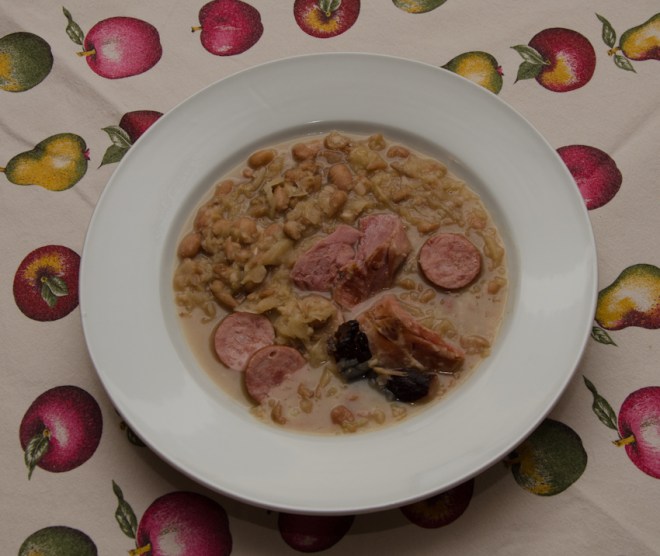Those who read Italian can tap into the link below for SBS Italian. The link also allows anyone who would like to listen to me discussing the recipe briefly with the SBS Presenter Massimigliano/Max Gugole). This is also spoken in Italian.

Recipe and podcast SBS Italian:
The following is a rough translation of what is on the SBS Italian website and what Max and I discussed.
Jota /Iota is a very ancient preparation much appreciated in Trieste (Friuli-Venezia Giulia), a territory with a complex history, it was first part of of the Austrian Empire and later of the Austro-Hungarian Empire.
When you look at a map of Italy and find Trieste, you see that the location of this city is close to Slovenia, Croatia and further north is Austria and the cuisine of Trieste has been influenced by these countries.
This thick soup is made with borlotti beans, “capuzi garbi” (the local name for sauerkraut), potatoes and smoked pork. For the latter component, sausages or a piece of cooked ham can be used. For meat on the bone, you can use ribs, a hock or ham on the bone.
It is a typical winter dish, rustic and full-bodied, which is eaten as a stand alone dish.
Jota is typical and is eaten not only in Trieste but throughout Friuli.
Like all ancient recipes, every family has its own recipe and there are many variations. Some put barley, polenta or a soffritto of a little oil sautéed with a little flour to make it thicker. Many also add a teaspoon of German cumin seeds (caraway seeds in English) and not to be confused with what we call cumin.
Experiment with this recipe. Feel free to add more meat or more beans or more sauerkraut, depending on your taste! And with a few more potatoes, the soup will be even thicker.
Ingredients (6 people)
400g sauerkraut, drained
400g of dried borlotti beans
400g of potatoes
4 – 6 bay leaves
2 cloves of garlic
Smoked pork: 2-3 sausages or a whole piece of cooked ham (about 400g), or a hock (about 1k) or ribs, or bone-in ham
extra virgin olive oil or lardpepper and salt to taste2 tablespoons flour (optional)
The night before, put the well-covered beans in a bowl to soak in cold water.
The next day, cook the beans in a saucepan with 2 bay leaves over low heat for about 40 – 50 minutes. Peel and cut the potatoes into pieces, add them to the broth with the beans and continue cooking for 20 – 30 minutes until everything is cooked.
Place half the potatoes and beans in a bowl with the broth, reducing everything to a puree/ mash. Then add the rest of the whole beans and pieces of potatoes.
In another pot, brown the crushed garlic cloves in a little oil or lard. When they are golden, add the sauerkraut and cover them with water. If you want you can add some bay leaves and/or caraway seeds.
Add the hock and/or smoked meat on the bone, and when it is almost fully cooked, add the whole sausages and cook for another 15-20 minutes. Remove the sausages and meat from the pot and slice everything, removing the bones.
Combine the vegetable broth with the beans and potatoes with the sauerkraut, the sliced smoked meat and its broth.Season with salt and pepper to taste.
OPTIONAL: In a small separate pan put two tablespoons of oil or lard, adding a little flour. Stir to avoid lumps. Once the flour has been toasted, add this sautéed mixture to the rest of the soup, mixing carefully.
ADDITIONAL NOTES
This soup should be quite thick. Add more broth or water if it is too thick.
It is even better if prepared a day in advance.
The beans and potatoes can be cooked days beforehand and kept in the fridge.
To cook a Jota with less fat you can cook the broth with the smoked meat in the water and the bay leaves. When the meat and the broth are cooked, if you have used meat on the bones, remove the bones and when the broth is cold remove the fat.
Sauerkraut can be bought either in jars or glass jars in delicatessen shops and supermarkets.
Smoked meat is part of German, Polish, Hungarian, Russian, Slovenian and Croatian gastronomy.
Pork hocks, ribs and cooked ham are readily available and can be found in supermarkets. Sausages can be bought in produce markets, some continental delicatessens and butchers or food specialty shops. In some supermarkets you can find commercial sausages: Polish sausage, Kramsky, Cabonossi and Kabana. I keep away from those wrapped in plastic.
Commercial cooked bacon if cured and smoked properly is cooked first and then smoked, but unfortunately, some manufacturers inject the meat with liquid smoke. (Use a reputable brand).
N.B. There are smoked products that are made with free-range pork and smallgoods/charcuterie manufacturers that use no artificial additives or preservatives.
There are other recipes for making Iota on my blog. For the SBS recipe I thought that I would simplify the recipe and write it more in keeping with the many variations of how to cook Iota in Trieste, so I suggested using two saucepans, one to cook the beans and potatoes and in the other the sauerkraut and pork.
Other recipes on All Things Sicilian and More blog:
Pork Hock, Polish Wedding Sausage, Borlotti and Sauerkraut =IOTA (a lean version)
IOTA (Recipe, a very thick soup from Trieste) Post 1
IOTA FROM TRIESTE, Italy, made with smoked pork, sauerkraut, borlotti beans














































 :
:





